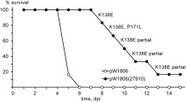Development of a human live attenuated West Nile infectious DNA vaccine
For the development of a human West Nile (WN) infectious DNA (iDNA) vaccine, we created highly attenuated chimeric virus W1806 with the serological identity of highly virulent WN-NY99. Earlier, we attempted to utilize mutations found in the E protein of the SA14-14-2 vaccine to bring safety of W1806 to the level acceptable for human use (Yamshchikov et al., 2016). Here, we analyzed effects of the SA14-14-2 changes on growth properties and neurovirulence of W1806. A set including the E138K, K279M, K439R and G447D changes was identified as the perspective subset for satisfying the target safety profile without compromising immunogenicity of the vaccine candidate. The genetic stability of the attenuated phenotype was found to be unsatisfactory being dependent on a subset of attenuating changes incorporated in W1806. Elucidation of underlying mechanisms influencing selection of pathways for restoration of the envelope protein functionality will facilitate resolution of the emerged genetic stability issue.
Development of a human live attenuated West Nile infectious DNA vaccine
Source: Virology News
